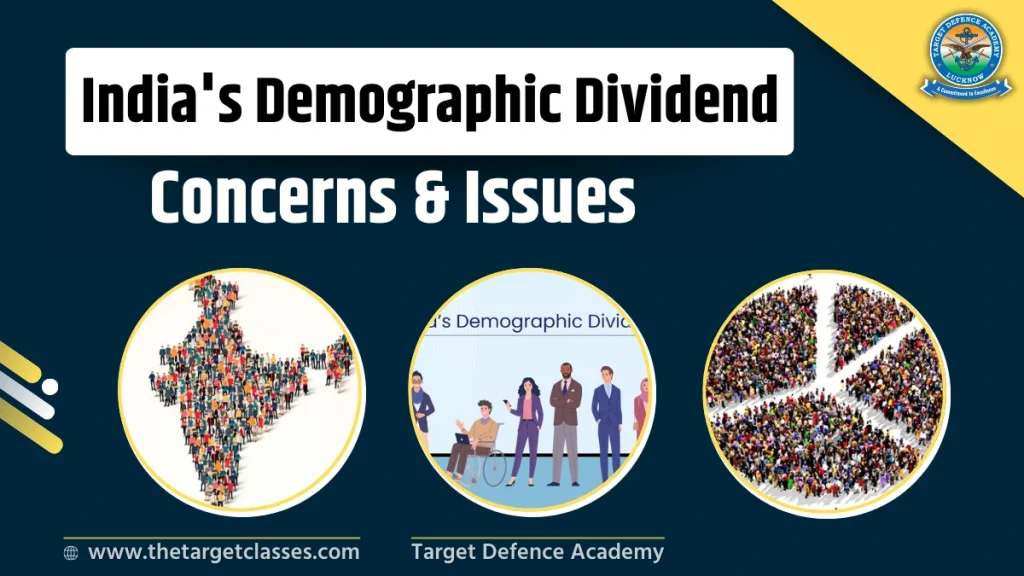Context
India’s youth is the country’s greatest asset, but this so-called ‘demographic dividend’ could become a liability when they have no required skills. Also, it may converge into crisis if structural issues remain unaddressed.
Demographic Dividend
(a) Rapid decline in a country’s fertility and the further changes in the population age structure result in the acceleration of the economic growth.
(b) It happens when a country’s working-age population (15–64 years) increases greater than its dependent population (children and elderly). As a result, increases productivity, savings, and economic development.
(c) Countries like China, Japan, and South Korea cash in on their demographic window make themselves global powers. At present, India has 835 million+ below 35.

Significance
(i) India is transitioning due to its demographic dividend, with over sixty five percent% of the population below 35 and a median age of 28. This favourable age structure ensures big opportunity for economic development, productivity, and making India as a global talent hub.
(ii) India’s working-age population will grow for the next 30 years( till 2055), providing enough time for strategic development. India’s risng middle class, digital penetration, startup ecosystem, and positives in IT, pharmaceuticals, and engineering further increases its global appeal.
Key drivers of India’s demographic dividend
(i) Rising working-age population, will cross 1 billion in next22 years, rapid urbanisation, digital employment through gig and remote work platforms, and rising entrepreneurship.
(ii) Key enablers include: development of urban regions through Smart Cities and integrated infra projects.
(a) IT hubs like Bengaluru and Pune gravitating and fostering global investment.
(b) women’s participation is ameliorating through policy reforms and support schemes.
(c) Education and skill development programs like Skill India are providing youth relevant skills for future.
Concerns & Issues
(i) Gap in Academic Training & Market Needs: Every year, lakhs of graduates join the workforce, but half of engineering graduates remain unemployed. Also, more than 60% of higher education leaders confirmed that curricula there are not in line with industry demands.
(ii) Outdated System in a Changing World: Country’s education system still emphasizes rote learning and outdated curricula while the future is artificial intellegence. Study shows that around 70% of jobs globally will be affected by AI.
(iii) Digital Tools, Analog Mindsets: While smartphones and digital access are more than enough, but teaching methods remain examination-focused. EdTech platforms have substituted practical skills with test prep, while industry-ready learning remains at far distance.
(iv) Missed Industrialization: India escaped the industrialization window. The IT and service sectors provide employment to only a fraction of the labor force, and laks remain underemployed in unorganised sectors.
(v) Policy Loopholes: The government has launched several initiatives — from the Skill India Mission to PMKVY, PMKK, JSS, PMYY, SANKALP, and others. Inspite of crores invested, targets remain blurred due to illconcieved approaches and lack of coordination with real-world demands.
- India’s Automobile Industry: NITI Aayog Report
- India’s Role in Ending Global Hunger: A Decisive Path
- Electoral Transparency in India
- Download the Mobile App of Target Defence Academy
Way forward
(i) Upskilling, Cross-skilling, and Reskilling: By 2030, seventy percent of jobs in India could be at risk from automation (McKinsey), while the World Economic Forum (WEF) predicts 170 million new jobs will be there globally — but simultaneously displacement of 92 million jobs of them will be there.
(iI) Education Reform: National education policy 2020 envisions to universalize access to education and ensure vocational training from early stages. Career awareness needs to be ameliorated — Around 90% of students know only 7 career options, when the economy provides more than 20,000.
(iii) Gender-Inclusive Growth: Programs like STEP( software students trainiing in engeneering programs) and the National Creche Scheme support working women and foster female participation in the workforce. Women make up around 43% of STEM graduates, but most of them drop out early.
(iv) Digital Economy & Innovation: Digital India and platforms like UPI have revolutionized transactions and created new job ecosystems. The digital economy will reach THree hundred fifty billion dollar by 2030(estimation), providing immense employment potential.
(v) Global Integration & Investment: India is positioning itself as a China-plus-one destination for global supply chains. With 1.04 billion working-age people by 2030, India offers unmatched human capital for global investors.
Conclusion
India’s future as a digital leader depends on how it manage this skills crisis. The challenge is real, but so is the opportunity. India can convert its demographic dividend into a genuine advantage, by making education in line with industry, increasing career awareness, and instilling skill development at every stage of learning. In the end, India must focus on job creation, inclusive growth, women’s empowerment, and continuous upskilling.

